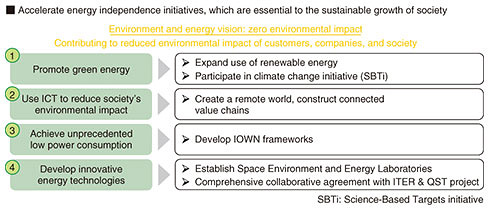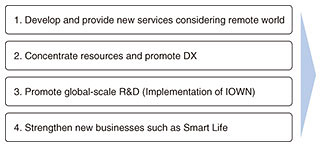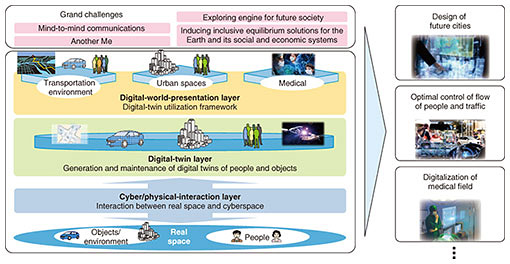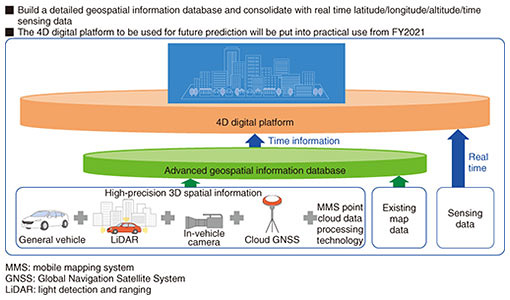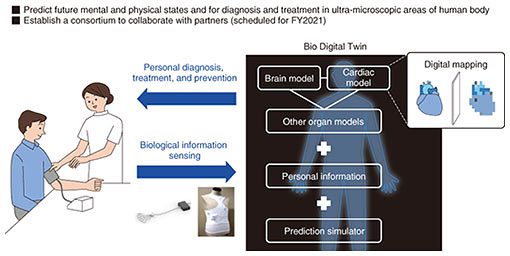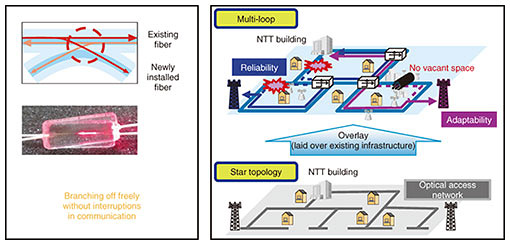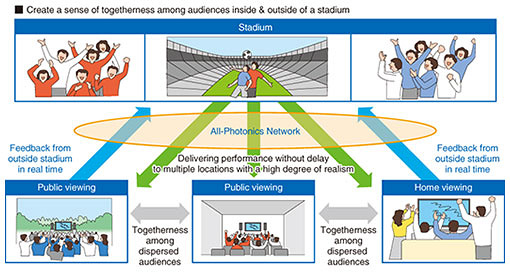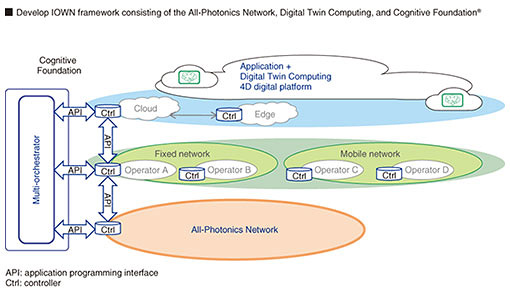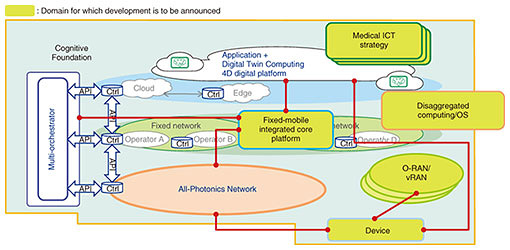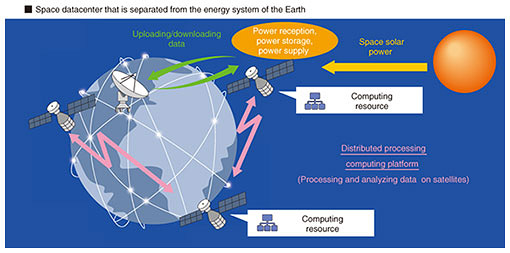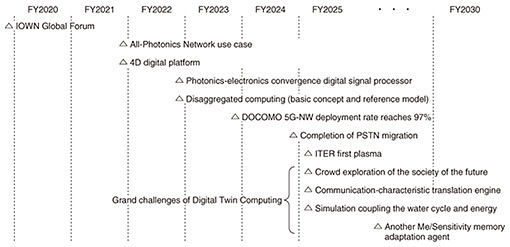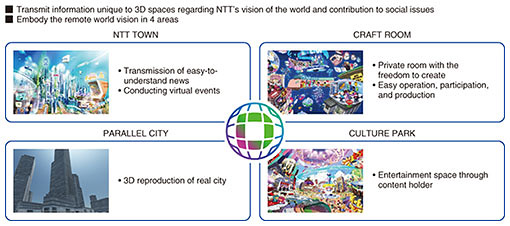 |
|
|
|
|
|
Feature Articles: Keynote Lectures at NTT R&D Forum 2020 Connect Vol. 19, No. 2, pp. 13–24, Feb. 2021. https://doi.org/10.53829/ntr202102fa1  Road to IOWNAbstractThe “Road to IOWN,” NTT’s initiatives aimed at implementing the concept known as the Innovative Optical and Wireless Network (IOWN), is introduced in this article, which is based on a lecture given by Jun Sawada, NTT President and Chief Executive Officer, at the NTT R&D Forum 2020 Connect held from November 17th to 20th, 2020. Keywords: IOWN, remote world, Digital Twin Computing, All-Photonics Network 1. IntroductionI will introduce the “Road to IOWN,” NTT’s initiatives to implement the Innovative Optical and Wireless Network (IOWN). Before that, however, I’d like to mention that NTT’s tender offer for shares of NTT DOCOMO, aimed at making NTT DOCOMO a wholly owned subsidiary of NTT, was successfully completed on November 16, 2020, acquiring approximately 91% of NTT DOCOMO’s shares. The purpose of this tender offer is to strengthen and grow NTT DOCOMO so that it can compete with GAFA (Google, Amazon, Facebook, and Apple) and other over-the-top players amid intensifying domestic and borderless competition. However, this is a rather reactive approach. By taking a proactive approach, we want to strengthen NTT DOCOMO in a manner that leads to the growth and development of the entire NTT Group (Fig. 1).
1.1 History of pandemics and hegemonyLet me shift the viewpoint a little. In 1602, Matteo Ricci, an Italian Jesuit missionary, published a world map in China, called the “Kunyu Wanguo Quantu,” which was introduced to Japan in the years after the Battle of Sekigahara in 1600. If we zoom in on this map, we can see four large islands drawn in the center, so we can see that Japan had already been recognized at that time. In other words, it is clear that from this era that Japan should recognize its role in the global structure. Now, as we bear the third wave of novel-coronavirus infection, let’s take a historical look at how humanity has dealt with pandemics (Fig. 2). The era when Japan was clearly depicted on the Jesuit map I just mentioned is debated as the time before the Spanish Empire dominated the world or was in the process of dominating. Before that era was the Islamic caliphates, which were preceded by the Mongol Empire. The Mongol and Spanish Empires had histories of taking hegemony in the wake of the plague and smallpox, respectively. During the Reformation, Holland gained prominence, and people moved from Spain in large numbers, shifting the world economic center to Holland.
In the 18th century, the technological innovation of the Industrial Revolution gave Britain hegemony. At that time, cholera spread from Asia to Europe and the United States. After that, the Spanish Flu raged for a couple of years from the end of World War I. Some people say that the Spanish Flu ended WWI; nevertheless, economic decline followed, and the United States emerged as the global power. We should bear this perspective in mind while carefully considering what kind of world is waiting for us beyond the current coronavirus pandemic. 1.2 Japan’s technology trade balanceThe Ministry of Internal Affairs and Communications of Japan has been compiling data on a technology trade balance for nearly 20 years (Fig. 3). The technology trade balance concerns export and import values for patents, knowledge, and other forms of technology transfers. Comparing exports and imports in this manner reveals that industry in Japan as a whole has a positive trade balance. In particular, I think that a positive trade balance is proof that Japanese technology, particularly related to automobiles and precision machinery, is used worldwide. On the contrary, Japanese technology has a negative trade balance in terms of information and communications. It might be better to say that it has always been negative. In other words, Japanese information and communication technology (ICT) companies purchase overseas technology and use it for their business in Japan. In 2014, a journalist said, “Few technologies—and products and services based on them—originate in Japan. The Japanese information technology (IT) industry, which does not contribute to the world at all, has no value as an industry; only an ‘IT utilization industry’ exists in Japan.” Being personally shocked by that comment, I thought that we should strive to make our next technology a game changer.
1.3 Post-coronavirus social trendsNext, I’ll talk about the current novel coronavirus pandemic. Although the novel coronavirus is still spreading rampantly, I’d like to take a look at trends in the so-called post-coronavirus society. There are two trends, the first is the remote world, in other words, a decentralized society. Although various discussions will probably carry on into the future, I think that the remote world is indispensable for achieving Japan’s carbon neutrality by 2050. It is necessary to ensure social distancing and simultaneously revitalize economic activities. In response to this need, the NTT Group has launched the new service brand called remote world. We want to provide a new environment that goes beyond face-to-face communication for remote working, medicine, and sports/entertainment viewing. The other trend is new glocalism. Globalism is still a necessary element; however, I believe that we also need localism that respects the culture of Japanese people and the different cultures of each region while recognizing diversity. Therefore, new glocalism requires a paraconsistent approach. The other day, when I was talking with the former President of Kyoto University Juichi Yamagiwa and Professor Yasuo Deguchi of Kyoto University, I was asked, “Do you know what is not included in the 17 Sustainable Development Goals (SDGs) set by the United Nations?” The answer that I should have given is “culture” because culture is basically rooted locally and the 17 SDGs are universal global targets. I think of glocalism as a concept through which we achieve the overall goals after understanding and accepting local cultures, without excluding any. I believe we should seek a society that recognizes the quality of life of each individual, rather than trying to control everything according to one way of thinking or uniform consciousness. Looking toward the post-coronavirus society from the perspective of economy, security, and country, I first think supply chains with reliable people must be established; second, IT must be used to accelerate digital transformation (DX) and build connected value chains. Third, energy independence must be ensured, and in accordance with that need, the NTT Group is promoting the use of green electricity (Fig. 4). We plan to increase the proportional use of renewable energy to 30% by 2030. In recognition of these actions, we have obtained certification by the Science Based Targets initiative (SBTi). However, the promotion of ICT is the base of our contribution to achieving energy independence; for example, carbon-dioxide emissions is estimated to be cut by about 70% by the adoption of teleworking. In other words, it is important to create a remote world and build connected value chains.
In July 2020, thinking that ICT could help create innovative energy technologies, we established NTT Space Environment and Energy Laboratories. We are also collaborating with the International Thermonuclear Experimental Reactor (ITER), which is being constructed in cooperation with seven countries and regions, and the National Institutes for Quantum and Radiological Science and Technology (QST) of Japan. To manage plasma while controlling nuclear fusion in a very short time, it is necessary to devise computing and communication methods for transmitting a massive amount (petabytes) of information to various places with ultralow delay. The ITER is scheduled for “first plasma” in 2025, and research and development (R&D) aimed at achieving that goal has begun. 2. The Road to IOWNToday’s main topic is IOWN, which is described with the keyword “game changer.” I’d like to start by introducing a message from Takashi Niino, President and CEO of NEC Corporation, which announced a capital and business alliance with NTT in June 2020. 2.1 Message from Takashi Niino, President and CEO of NEC Corporation“Hello everyone. I’m Takashi Niino from NEC. First, I’d like to congratulate NTT on holding the NTT R&D Forum. As you all know, in June of this year, NEC and NTT entered into a capital and business alliance for the purpose of R&D and global expansion of ICT products that use innovative optical wireless technology. Through this alliance, we aim to cooperate over a long period as equal partners that transcend the boundaries of operators and manufacturers. I’ll start by briefly explaining the purpose of this alliance. While promoting the spread of the Open Radio Access Network (O-RAN) Alliance specifications, we will develop base stations that are O-RAN compliant and internationally competitive and aim for the top share in the future global market. We will also develop a compact photonic integrated circuit with the world’s highest performance and low power consumption and information and communication equipment incorporating it and market that equipment globally. What’s more, we will strive to develop innovative optical wireless devices that contribute to implementing IOWN as well as upgrading technologies related to, for example, submarine-cable systems, space communications, and security. As one of the world’s leading telecommunication operators promoting the introduction of advanced technology, NTT has industry-leading R&D and technological capabilities with regard to photonics and compact photonic integrated circuits. In the meantime, NEC has a wealth of expertise in building communication infrastructure that ensures the quality and reliability required by operators as well as world-class advanced communication technologies and digital technologies such as artificial intelligence and security. I am convinced that by joining hands with NTT, we can contribute to strengthening Japan’s industrial competitiveness and further ensuring the safety and reliability of communication infrastructure. So, President Sawada, let’s make this happen together. Thank you for giving me your kind attention today.” Thank you, President Niino. NEC and NTT plan to jointly develop a wireless access network compatible with O-RAN-compliant multimedia while preparing for the fusion of photonics and electronics, namely, IOWN. 2.2 Directions of NTTNTT is heading in four directions, as shown in Fig. 5. The first direction is the provision of new services suitable for the remote world. The second direction is how to promote DX while concentrating resources of the entire NTT Group. The starting line in that direction was the tender offer for shares of NTT DOCOMO. The third direction is the implementation of IOWN, which is today’s main topic. And the fourth direction is strengthening new businesses, including our global ones.
A contribution we will make to society is strengthening the international competitiveness of the Japanese ICT industry. In particular, we’d like to lead the world in the advancement of information and communications in new areas such as space and underwater. Improving national security is also worth mentioning. Besides cybersecurity, we are also discussing business continuity plans and countermeasures against disasters. We want to further develop and expand the ICT industry as a whole. Today, I’d like to introduce four distinctive technologies for achieving the third direction in which NTT is aiming for, namely, implementation of IOWN. Before that, I’d like to introduce a message from Akio Toyoda, President of Toyota Motor Corporation. 2.3 Message from Akio Toyoda, President of Toyota Motor Corporation“Hello everyone. I’m Akio Toyoda. When we came up with the idea of the “Woven City,” I felt that it would never be possible without the help of NTT. I announced the Woven City concept at the Consumer Electronics Show held in Las Vegas in January of this year (2020), and soon after that, I went to see President Sawada. At that meeting, Mr. Sawada and I agreed that we want to make a human-centered city where people can live with peace of mind and live happy lives without being controlled and monitored through information. Since the two of us held a press conference last March, our work to create the Woven City has started. When I talked to the Toyota side, they said that NTT is more like a teacher than a partner in creating smart cities. They said that, first, they put everything we both had on a table. They were amazed by what NTT put out: NTT came up with not just the communication, energy, and administrative relations that we had imagined but also the expertise necessary for people to live fulfilling lives, such as in medical care and entertainment. After all, we at Toyota alone cannot help people build fulfilling lives. The phrase ‘new normal,’ which I had never heard before this initiative began, has become a more common word. Together with NTT, I want to continue to create a city where people can really be happy in the new normal. This cannot be accomplished by Toyota and NTT alone. It can be accomplished through the aspirations and technologies of many people. I am looking forward to our continued collaboration with NTT and thank you everyone for your kind attention.” Thank you, President Toyoda. 2.4 Digital Twin ComputingThe Woven City will be built in Higashifuji in Susono City, Shizuoka Prefecture; after that, smart cities will be promoted in Shinagawa Ward in Tokyo and cities around the world. In addition, the main focus of the collaboration is to create a platform of platforms that connects those cities, and the story of that collaboration leads to the development of Digital Twin Computing (Fig. 6). The idea behind Digital Twin Computing is forming another city in cyberspace, making predictions and simulations for various scenarios, and using these results to improve the lives of residents or ensure smooth operation of urban facilities in real space. Creating a positional starting point is important to enable the designing of future cities, optimal controlling of people and traffic flows, and smarter medical fields through Digital Twin Computing. The current two-dimensional (2D) maps should be converted into 3D, then, by adding a time axis, into 4D. To accumulate those 4D map data and integrate sensing data of people and objects with highly accurate position and time information to be used for future prediction, it is essential to develop a cross-industry infrastructure. We call this infrastructure the “4D digital platformTM” (Fig. 7). I’m thinking that this infrastructure will be used as the starting point for cyberspace or smart cities. We will start practical use of the 4D digital platform in 2021.
Another use case of Digital Twin Computing that I should mention is a personal medical solution (Fig. 8). NTT is currently researching a Bio Digital Twin. By sensing biological information about the brain and heart and combining it with a prediction simulator and personal information such as physiological and behavior information, the Bio Digital Twin will be useful for diagnosis and treatment in ultra-microscopic areas of the human body. Considering our ultimate goal should be to improve the quality of life of humankind as a whole, I’d like to discuss the development of Bio Digital Twin technology that will help humanity as a whole and social acceptability.
2.5 All-Phonics NetworkNext, I’ll talk about the All-Photonics Network. Global Internet protocol (IP) traffic is projected to increase 1.5 times in two years, and IT power consumption is projected to increase 1.6 times in five years. Under such circumstances, NTT aims to introduce all-optical technology into its communication infrastructure. Current optical access networks have a star topology, and lines are drawn from NTT buildings to customers one by one. We want to overlay multi-loop access networks over existing networks. This concept is a world first, and the key to it is a technology for freely branching optical fibers without interrupting communications. This technology is still being researched, but once we have implemented it, we will be able to create a reliable and adaptable access network (Fig. 9).
I’d also like to introduce distributed ultra-reality viewing as a use case for the All-Photonics Network (Fig. 10). In the post-coronavirus society, many people will watch sports from home without even entering a stadium. We want viewers to share a sense of presence with the stadium, through cheers and atmosphere, in an interactive manner while conveying the performance of athletes to those viewers without delay.
2.6 Photonics-electronics convergence device/disaggregated computing modelWe are currently working on a prototype of a photonics-electronics convergence device that will be complete it in two years. The first step of this prototyping is to adopt an optical-electronic co-packaging as an input-output device for large-scale integrated circuits, which are the core elements of silicon photonics. The next step is to achieve inter-chip transmission by optical wiring. In the following step, intra-chip transmission is achieved using optical elements. We plan to introduce a disaggregated computing model—in place of the conventional physical-server (box)-oriented computing model—using that photonics-electronics convergence chip to connect functional modules such as central processing units, graphics processing units, and memory via light. Implementing this model requires an ultra-powerful white box and a new operating system. 2.7 Concept of IOWNIOWN consists of the All-Photonics Network, Digital Twin Computing, and Cognitive Foundation® (Fig. 11). The huge amount of data involved in Digital Twin Computing and its 4D digital platform will be supported by using the end-to-end All-Photonics Network. What’s more, although core networks of mobile networks and fixed networks are currently separated, I think we will need to integrate them into one platform.
Our medical ICT strategy, including the personal medical solutions I mentioned above, is located in the domain of Digital Twin Computing. On the contrary, O-RAN/vRAN (virtualized radio access network) and associated devices are positioned on the infrastructure side. We are pushing ahead with R&D under the assumption that the disaggregated computing model will support all these domains (Fig. 12).
2.8 IOWN space computingNext, I’ll talk about space computing, namely, a space datacenter separated from the Earth’s energy systems (Fig. 13). For example, we are considering mounting computing resources on low-earth orbit satellites and connecting the satellites to form a distributed processing computing platform. Raw data are transmitted to the satellites using laser transmission, and the results of calculations and analysis are returned to Earth also using laser transmission. It has been decided that multiple-input multiple-output (MIMO) technology will be installed on satellites in a year and a half, so I think such technology can also be used for space computing.
2.9 IOWN roadmapThe roadmap for the implementation of IOWN is shown in Fig. 14. In 2020, the IOWN Global Forum was established. In 2021, use cases of the All-Photonics Network will start to appear, so we will continue to study how to reflect the results of those use cases in our equipment. In addition, the first version of the 4D digital platform will likely be released in 2021. In 2022, we plan to announce the development of the photonics-electronics convergence digital signal processor. We will also investigate the basic concepts and reference models of disaggregated computing. Regarding NTT DOCOMO, we are aiming for a deployment rate of the 5G infrastructure of 97% in Japan by 2023. The migration from the public switched telephone network (PSTN) to IP telephony will be complete by 2025. Also, in 2025, the first plasma of ITER nuclear fusion will be carried out, and as “grand challenges” concerning Digital Twin Computing, we are planning crowd exploration of the future society, a communication-characteristic translation engine, and a simulation coupling the water cycle and energy. Looking further into the future, we have set the goal of R&D on “Another Me” (namely, a coexistence alter-ego technology) for 2035 in consideration of the considerable time it will need to develop it.
2.10 Toward further sustainable growth of societyWe want to make IOWN a game changer. With the IOWN elements of photonics-electronics-conversion devices, the All-Photonics Network, disaggregated-computing model, and 4D digital platform, we want to promote various initiatives so that IOWN will bring about societal changes. We envision two major trends in the post-coronavirus society—the remote world and a new glocalism. By introducing IOWN in such a society as a game changer, we want to help make a more independent Japan while contributing to the world. 3. Concluding remarksMany people are accessing the NTT R&D Forum via the Internet. The concept of digital events will become more common in the future. Therefore, we prepared a website for sharing ideas in 3D about NTT’s vision of the world and its contribution to social issues it has targeted (Fig. 15). We want to make it a place for incubating technologies in a manner that enables us to share information or just go there and enjoy it. NTT will move ahead with R&D and business activities to become a game changer to change the world for the better. Thank you for your continued support.
|
|












